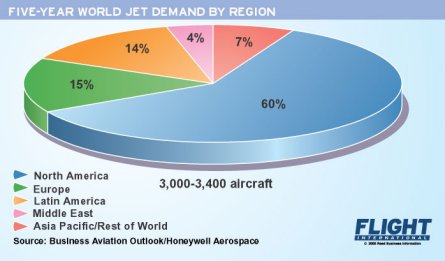Deliveries of over 800 business jets predicted for next year as industry recovery sustains momentum
Honeywell Aerospace expects 2006 to set a business jet delivery record of more than 800 aircraft. But this could be a peak, with a cooling off expected until the end of the decade, when deliveries could resume a climb towards 1,000 aircraft a year by 2015.

“The industry recovery that began in 2004 has gained momentum in 2005,” says Frank Daly, vice-president, marketing and product management, unveiling the US aerospace supplier’s 14th annual business aviation outlook. If economic expectations hold, he says, 2006 “should be a record year for business jet deliveries, topping the previous peak in 2001”.
While the 2005 survey forecasts record deliveries next year, it also reveals a decline in operator purchase expectations for the first time in four years. Operators surveyed expect to replace or expand 21% of their fleets over the next five years – down from 25% last year – generating demand for 3,000-3,400 aircraft, excluding fractionals.
While increasing in all other regions, purchase expectations in the dominant North American market fell to 16%, Honeywell says, because of recent orders and deliveries and concerns about rising fuel and insurance costs and the possibility of airspace user fees. As a result, deliveries are expected to flatten off at 800 a year to the end of the decade, before climbing towards 1,000 a year by 2015.

Manufacturer backlogs had passed the 1,900 aircraft mark by mid-year, Honeywell estimates, with fractional ownership accounting for 30-35% of orders. While share sales have slowed, shareowner flying is up and jet card sales are soaring. “Fractional fleets will likely continue to experience very high utilisation, resulting in capacity constrains and even aircraft shortages if current trends continue,” says Daly.
The company is forecasting delivery of 9,900 business jets worth $156 billion between 2005 and 2015, including more than:
1,500 long- and ultra-long-range aircraft in the Bombardier Global, Dassault Falcon 900/7X and Gulfstream G450/G550 class;
1,000 large jets in the Bombardier Challenger 604, Falcon 2000EX, Embraer Legacy and G350 class;
2,500 medium and medium-large aircraft in the Bombardier Learjet 60, Challenger 300, Cessna Citation Sovereign/X, Falcon 50EX, G150/G200 and Hawker 800XP/Horizon class;
2,900 light and light-medium jets in the Learjet 40/45, Citation Bravo/CJ3/Encore/XLS and Hawker 400XP class;
1,900 very light jets in the Beechcraft Premier I, Citation CJ1/CJ2/Mustang, Embraer VLJ and Sino-Swearingen SJ30-2 class.
For the first time, Honeywell has included the general aviation segment in its business aviation outlook, forecasting demand for 4,500-5,500 ultra-light or personal jets over the next 10 years. The company includes in this market segment the Adam A700, Diamond D-Jet and Eclipse 500.
The cut-off between very-light and ultra-light jets in Honeywell’s survey is at around the $2 million price mark. “Below that price you get into owner-pilot aircraft like the Eclipse and A700,” says Charles Park, director market analysis. “These are not typical flight-department aircraft, although there is some cross-over.”
Traditional corporate flight departments surveyed indicated a potential 10-year demand for 800-900 ultra-light jets, Honeywell says. In addition, a survey of owner-pilots forecast demand for another 3,700-4,600 aircraft, excluding air taxis and fractionals.
- Aircraft manufacturer Embraer forecasts deliveries of 9,680 business jets worth $144 billion over the 10 years 2006-16. The company projects demand for 2,515 very light jets – including its own $2.75 million VLJ now under development, but excluding an air-taxi market tentatively estimated at 2,500-3,000 aircraft.
Although VLJs make up 26% of forecast aircraft deliveries they account for only 4% of the total dollar value. A projected 1,755 light jets make up 18% of deliveries and 8% of value. A forecast 1,415 super mid-size jets, including the Legacy, account for 15% of deliveries and 29% of value.
Source: Flight International
















